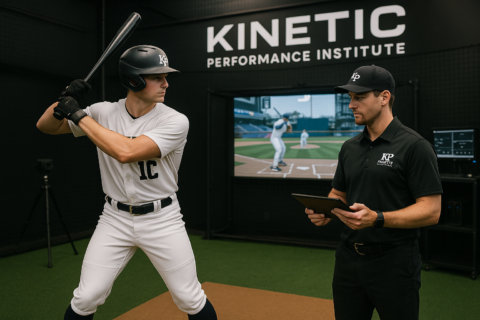Beating the Trends: KPI Keeps It’s Hardest Throwers the Healthiest
In the last 10 years as velocity training has become more effective and pitchers of all ages are throwing harder. There is a prevailing thought, with accompanying research, that the harder a pitcher throws, the more stress they place on their soft tissue (muscles, ligaments, tendons, nerves, etc). While this is a valid claim, KPI’s systems are proving that this does not have to be the trend and we are keeping our hardest throwers the healthiest.
The Problem – Pitchers Need to Throw Harder But It Usually Leads to Increased Stress on Soft Tissue
Modern training has forever changed baseball. It used to be thought that velocity was inherent and could not be trained, now we see many velocity training programs that are highly effective. More and more pitchers are throwing harder at younger ages to advance to the highest levels of the game. We know that velocity has the strongest correlation with pitcher advancement up the levels of baseball. But we are also seeing injury rates skyrocket for pitchers. Several prominent research studies state that as velocity goes up, stress rates and chances of injuries rise with it. On the surface, this makes perfect sense. But at KPI we believe that it doesn’t have to be that way.
KPI’s Data – We Keep The Hardest Throwers Healthy
We currently train about 128 high school pitchers. We took the top 20 hardest throwers and tracked their injury rates and usage over the last year…
- Average Max Velocity – 91.5 mph
- 3 of the pitchers came to KPI after an injury seeking rehab. All of those pitchers are healthy and on-pace to return to pitching for their high schools this Spring
- 2 of those 3 pitchers returned to pitching without injury in the Summer and Fall seasons
- Of the 17 pitchers that did not come to us injured…
- 16 made every start/appearance for their high school and club teams last Spring and Summer (and Fall if they played)
- 1 pitcher missed 3 weeks of his high school season out of precaution because we felt his stress levels and arm care numbers were putting him in an elevated injury risk status
- This pitcher returned in the Summer and has been healthy ever since and is now our hardest throwing pitcher
- 0 pitchers have had an injury or surgery
The KPI Way – Health First for the Hardest Throwers
We are extremely good at training velocity… the athletes in the #kpicrew display that constantly. But we take a health first approach to our high velocity pitchers and we buck the trends to keep them incredibly healthy. Pitcher injury rates at the Division I level are above 40% and for the pitchers in our building that will make it to that level, we are near 0%.
Our system is complicated, comprehensive, and nuanced, but here are some of the main ways we give the hardest throwers everything they need to get and remain healthy…
- Assessment-Based Training – we give our hardest throwers regular re-assessments of their mobility levels. We look for small changes and adaptations in their bodies and we adjust programming immediately if we see something off or asymmetrical.
- Force Plate Strength Workouts – We use force plates in a much more nuanced way than other performance centers. While most only track Peak Force Output, we dive much deeper into the Central Nervous System and train each pitcher’s individual movement deficiencies. Many hard throwers are already good at producing force and they need a better system that attacks other areas of their movement tendencies.
- Arm Care System – We use dynamometers multiple times per week to test the range of motion and strength levels of the pitchers’ arms. We adjust their training if we notice imbalances and we can progress or regress their throwing based on this data.
- Annual Throwing Calendar – Our hardest throwing pitchers are on strict throwing calendars. They go through periods of de-load and on-ramping over the course of the year. They do not play in competitive situations for 5 of 12 months in the year and they have a very methodical, 14-week on-ramp to prepare for their high school seasons.
- Recovery Routines – We have strict recovery protocols the pitchers follow and we have advanced technology to assist with their rejuvenation and regeneration after stressful throwing sessions. We have certifications in soft tissue and cupping to put our pitchers on a strict and methodical routine where recovery is prioritized.
- Trust – We build strong relationships with the pitchers in our building and they trust our messaging. If we tell them something, they listen and follow our prescriptions. They understand we are unbiased and this is what we specialize in, and that relationship allows us to navigate some sensitive waters when a field coach might be more concerned with a win over an individual’s health.
There’s a Better Way – Both Goals Can Be Accomplished
Advancing as a pitcher through the levels of baseball is one of the trickiest propositions of any athlete in sports. The numbers tell us that velocity must be a priority and the numbers also tell us that as that velocity rises, so does a pitcher’s risk of injury. If a pitcher is injured they are not of use to anyone. So a normal pitcher is caught in a significant conundrum, but at KPI we have developed incredible systems that can accomplish both goals and keep the #kpicrew pitchers on the field throwing fuel.


